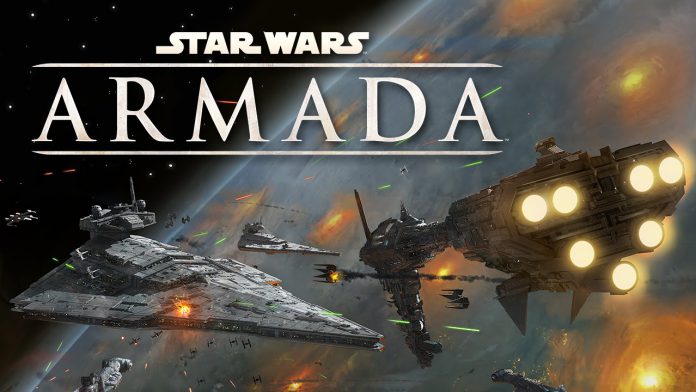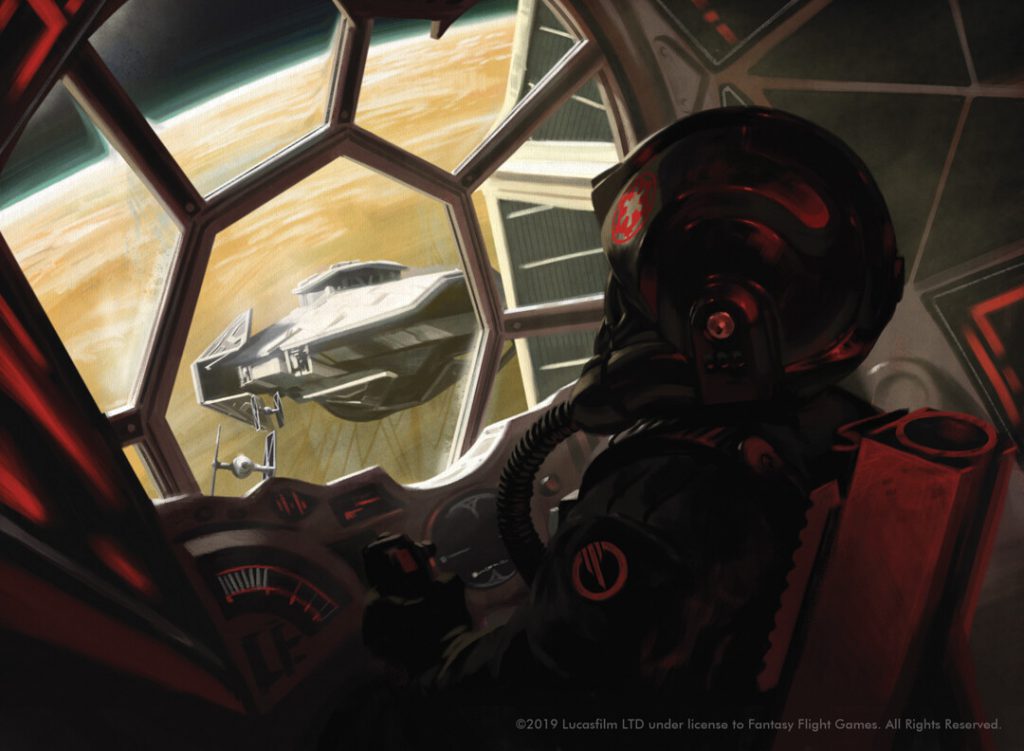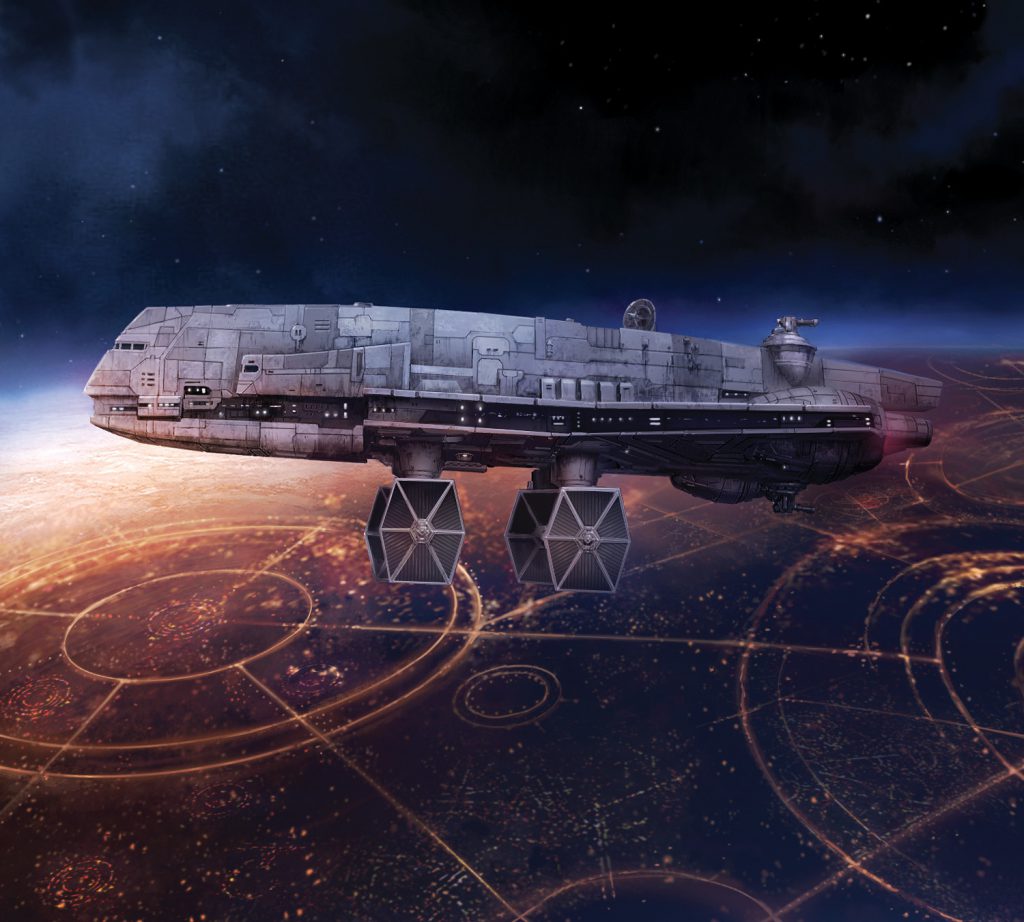Hi again. Summer’s dragging you to the Academy of Carida for flight operations school. Bring a pencil, it’s going to be a long one.
The Tip of the Spear – “This is where the fun begins.”
Star Wars Armada is centred on capital ship combat, but the squadrons darting between your warships play their own crucial role. They offer benefits from objective control to anti-bomber screening, and players always have the option to tailor a squadron complement to their needs. Fleets can operate with no fighter squadrons, be built around them, and anything in between. Even if you don’t intend to use them, it’s imperative to learn how to counter them. This article will discuss the basics of adding squadrons to your fleet, and a later article will go into basic tactics. It’s a big topic, and I’m going to try and do justice to the justice in two articles. Daunting.
In Armada, squadrons are little units on round bases that represent fighters, bombers and other strike craft too small to warrant classification as a warship. They share some basic mechanics as capital ships, such as alternating activations (in pairs), rolling dice to attack, and having HP. They also have greater freedom of movement, and a roster of special rules that define their roles. They also have a phase of the game dedicated to their use: the Squadron Phase (p. 10).
A lot of players (myself included) started Armada wondering about the point of squads. After all, if we wanted to fiddle with X-wings, we’d play the eponymous wargame. This is a game about capital ships! While Armada is about capital ship combat, fighters give your fleet flexible and cheap support. Ignoring their utility means losing a whole world of mobile map control, protection and damage. Aircraft did drive big-gun battleships to extinction, after all.
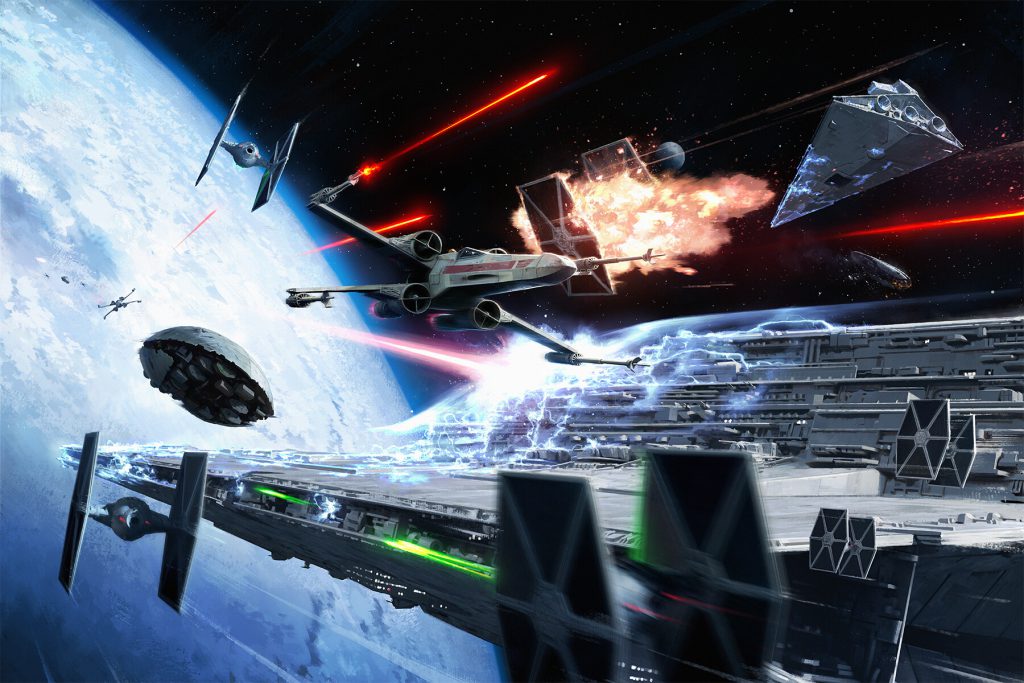
Before I go further, I present a glossary of basic terms. I will refer to most of these throughout the article, so keep this section in mind.
Glossary
Basic Terms
Ace: Colloquialism defined as a unique squadron with defence tokens. Aces are differentiated from unique squadrons without defence tokens because the game imposes a hard limit on the number of unique squadrons with defence tokens in a fleet (p. 6). Examples: Wedge Antilles, Odd Ball
Anti-Squadron/Anti-Ship: Like ships, squads roll different dice when attacking ships and other squads. Anti-squadron attacks are represented by an icon with three blue bolts (p. 15). Anti-ship attacks are represented by a red icon with one bolt (p. 13). The correct dice must always be used when attacking a corresponding target.
Bomber: Any squadron with the Bomber keyword, which allows critical results on dice to deal damage and resolve the standard critical effect. Great for killing ships. Examples: TIE Bomber Squadron, ARC-170
Carrier: A capital ship outfitted for naval aviation. Usually issues Squadron Commands in conjunction with upgrades and titles. The term usually describes a warship fitted for a carrier role, although the Galactic Empire does have a dedicated Light Carrier.
Keyword: Squadron keywords are generic special rules associated that grant effects to the unit. Different squads can share keywords. This differentiates them from special abilities, which are unique to aces.
Speed: Squadrons use the range ruler (distance side) to measure their movement range. Their maximum movement range is a number called Speed. When they move, they may end their movement anywhere within their Speed value, measured from the base. The minimum base Speed of a squad is 2 and the maximum base Speed is 5.
Squadrons/Squads/Fighters: Catch-all terms used by Armada players to describe squadrons, which are sub-capital ship units on round squadron bases. Although the term fighter is technically inaccurate, its use in Armada stems from the fact that squadrons tend to be released in factional ‘Fighter Squadrons’ expansion packs.
Squadron Command: A command that can be assigned to ships. When the ship resolves this command, it can activate squadrons during the Ship Phase. The activated squads can move and/or shoot during their activation. This command allows fighters to activate earlier than the Squadron phase and to greater effect. This is the main offensive command used by carriers.
Populating the Flight Deck – “Well, you know the Rogues. All we need is a ship and a rock to land it on.”
So let’s say that you want to integrate squadrons into your fleet (good.). Where do you start? Cannot Get Your Ship Out’s (CGYSO) squadron index has been the leader in basic squadron theory for Armada. Rightfully so – it’s an outstanding resource for the basics. I don’t plan on unseating them, but I also don’t want to join the cavalcade of people who tell new players to just read CGYSO, even though that’s exactly where I started. I’m going to try and discuss squadron fleet-building principles in a single, accessible article with an angle toward new players. See how it turns out.
Know Your Service Ceiling
Before we get into fleet-building, you need to know the limits of what you can do in reference to squadrons (p. 6).
- The 33% Rule: A fleet cannot spend more than 33% of its points (rounded up) on squadrons. The maximum fighter expenditure in a standard 400-point fleet is 134. Some special formats like Task Force, campaign expansions and homebrew have their own rules.
- The Ace Cap: A fleet may contain one unique squadron with defence tokens per 100 points of the agreed-upon point total for a game. These are known as ‘aces’. The maximum number of aces in a standard 400-point fleet is four. This limit does not apply to unique squadrons that don’t have defence tokens.
- Faction Lock: The contents of your fleet must align to a single faction. Everything is either one faction, or ‘generic’ and not faction locked. Basic, but important.
The first two rules impose profound limitations on how fleets are constructed. The 33% rule has been in effect since release, but the ace cap was introduced later. Aces tend to be extremely cost-effective and bring powerful abilities, so a limit was imposed for game balance. The ace cap has made the choice of aces more important, and has indirectly increased the value of non-ace squadrons.
A Budget Oriented Approach to List-Building
CGYSO’s squadron index describes what I call budget oriented list-building. Players who learn from that school of thought (myself included) will recall reading about their fighter coverage groups, which can be summed up as follows:
Small Fighter Coverage: Use a minimal number of points to build a small group designed to delay bombers and escort your ships. Your fighter complement is meant to be an effective defence while maximizing cost-effectiveness.
Medium Fighter Coverage: Use a moderate number of points to build a flexible group that can impede a bomber fleet or defeat a smaller group. Survivors can move on to do supplemental damage to enemy ships. This complement is highly flexible and can be built to operate with or without carriers, defensively or offensively. It’s the catch-all space where players invest more substantially into squads without making their entire strategy focused on them.
Large Fighter Coverage: Use a large number of points to build a strong fighter/bomber group – usually with carrier support. Here, squadrons form a major part of your fleet strategy and are a major source of damage. Consequently, the investment is high and the loss of your fighters or carriers is a severe blow.
Budget oriented approaches tend to allocate a slice of budget at the strategic level and fill out the fleet accordingly. The driving questions behind it are, how much budget am I willing to allocate, and what can I get out of my budget? The role of your squadrons is largely determined by your point budget and you modify it until you have a strong product. If you want to start with that classic approach to building, I highly recommend sitting down with CGYSO and a snack. Work your way through those articles. I’m not going to get paid for paraphrasing another blog all day so, I’m going to present another approach.
A Needs Oriented Approach to List-Building
In my head, I uncharitably refer to this as the fuck around and find out school of list-building. Needs-oriented list-building starts with a different driving question: what needs does my fleet have, and how do squadrons factor into that? Then you fill out those needs with appropriate units. Technically, this approach is points-agnostic and doesn’t care about how many points are spent. The reality of competitive play is that CGYSO’s guidelines tend to hold true due to the interplay of game rules and mechanics. A low-cost bomber group will seldom succeed in a highly competitive match, etc. However, starting with a question about needs expands our perception of squadrons beyond budgeting and the basic fighter and/or bomber approach. You can better involve features like objective manipulation and specialist commanders alongside classic concepts like bomber fleets and light fighter coverage.
The Driving Question
What needs does my fleet have, and how do squadrons factor into that?
Fighters can fulfil many roles in a fleet, but given the limitations on how many you can have, you need to make compromises. This approach to fleet-building is guided by the driving question above. It can be asked at the start of fleet-building, which gives primacy to your faction’s characteristics, ship collection and local meta. You could also ask it at the end of fleet-building: you have leftover points and gaps to fill. What are those gaps, and what can you use to fill them? That can take you back to a budget-oriented approach.
Some examples:
- You are a Separatist Alliance player. As you start building a new fleet. You are aware your basic squadrons (Vultures, Tri-Fighters and Hyenas) all have the AI keyword. AI units have inferior damage output for their cost, but when activated by a Squadron command, they get extra attack dice of any colour already in the pool. This raises their damage output while giving the player a choice of how to tailor that damage for each target. This presents a shortcoming in base effectiveness, and a need for carrier support for your fighters. When building your fleet, carriers based on ships like the Munificent-class Comms Frigate or Providence-class Dreadnought (yes, Dreadnought.) are a greater priority. Successfully addressing your need for carriers makes your cheap and numerous fighters highly lethal, especially if paired with an appropriate commander.
- You are a Rebel Alliance player. You’ve decided on a fleet anchored on Kyrsta Agate in a Starhawk. There’s an Assault Frigate II B and a CR90 A for fire support, but you haven’t got a dedicated carrier. You’re aware that fleets centred on a high-value large ship are highly vulnerable to bomber attack. Ships have a hard time killing bombers, and bombers love to overwhelm high-value targets with incremental damage. Your fleet has plenty of firepower and durability, but you need a low-maintenance fighter screen to delay bomber attack. So why not take Jan Ors, Biggs and a pair of X-wings? It’s the classic Rebel tarpit. This group ties down an enemy bombers while the aces’ abilities provide disproportionately high durability to the whole group. They can serve their tarpit purpose with little support, so they’re quite independent.
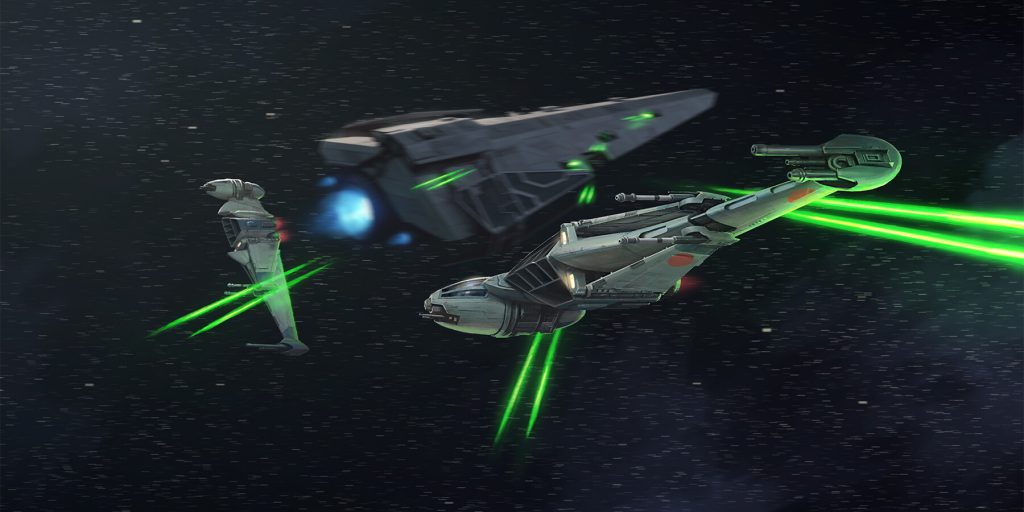
Identifying Roles for Squadrons
Before you can answer the driving question, you’ll need an understanding of what roles are available for squads and their support assets. Here are two ways to figure it out.
Read the card.
The simplest way to figure out what a unit does is to look at its card and read the keywords. Bomber makes it more effective at damaging ships. Rogue makes it less dependent on Squadron Commands from carriers and conversely, non-Rogues are more dependent on carriers. Swarm is like group sex: better with friends. The card also shows each squad’s stats in full. You’ll want to consider basic values like Speed, HP, number of dice and cost. For the advanced reader, the colour of its dice pool and how it interacts with special abilities becomes relevant. Maybe your commander favours certain squads, which defines what you should bring.
Easy example: TIE Fighters have Speed 4 (good), 3 HP (worst), are super cheap and have Swarm. It becomes pretty clear what they’re meant to be: expendable, speedy fighters that fly with friends.
So read the card, familarise yourself with the wiki and you’ll have a basic grasp on what a squadron does. Read things like CGYSO and find a community. Learn by playing.
Consider special interactions
Familiarising yourself with the card is good, but there are a ton of things that interact with squadrons. Some of them completely change the way you use your fighters, or alter your fleet strategy wholesale. Admiral Sloane’s ability only works on non-Rogue squadrons, but makes them a credible threat against enemy ships by stripping away defences. In a Sloane fleet, all non-Rogues can technically fill the role of… defence penetrator or something. Commander Sato’s ability requires squads to remain close to ships. A Sato fleet calls for durable squadrons to fill the role of ship hugger. If you picked Intel Sweep as as your navigation objective, a Strategic squadron can tilt the match in your favour. Therefore, Intel Sweep calls for an objective manipulation squadron with Relay. And so on.
Results
After putting thought into the cards, characteristics and special interactions available, you get some outputs. Here are some examples of where my thought process leads. Yours will take you to different and interesting places.
Battlecarriers: Frontline warships fitted for a secondary carrier duty. Intended to command squadrons and fight the main battle. Examples: Nevoota Bee, Venator II, Providence-class Dreadnought, non-Kuat Refit Imperial-class Star Destroyer, all fitted to balance combat and carrier-roles.
Support Carriers: Ships that can be fitted for carrier or fleet support duty. Intended to act as a second line vessel, or not fight at all. Generally smaller, cheaper and less durable than battlecarriers. Examples: Imperial Light Carrier, Centicore, Yavaris, GR-75 Transports, Gozanti-class Cruisers, Rebel Pelta, all fitted for carrier and support roles.
Escort Fighters: Fighters designed to kill enemy squadrons and protect friendly squadrons. Always have the Escort keyword. Examples: X-wing, TIE Advanced, V-19 Torrent
Bombers: Squads designed to attack and destroy enemy capital ships. Usually very vulnerable to fighters. Always have the Bomber keyword. Examples: BTL-B Y-wing, B-wing, Y-wing, Hyena-class Droid Bomber, TIE Bomber, Scurrg H-6 Bomber
Independent Bombers: Bombers with the Rogue keyword, allowing for less dependence on carrier support. Examples: Firespray-31, Lancer-class Pursuit Craft, Rogue Squadron, Dash Rendar, Corran Horn, Ketsu Onyo
Fighter-bombers: Squadrons that can pull double-duty as fighters or bombers. Usually expensive and less effective at each task than a specialised unit. Examples: X-wing, ARC-170, TIE Defender, Rogue Squadron, Dash Rendar, Boba Fett, Luke Skywalker, Darth Vader (TIE Defender)
Interceptors: Extremely fast, lightly protected fighters designed to attack enemy squadrons. Most effective against vulnerable targets like bombers and support craft. Often have very high base speed and the Counter keyword. Examples: Droid Tri-fighter, Delta-7 Aethersprite, A-wing, TIE Interceptor, IG-88, Tycho Celchu, Shara Bey, Soontir Fel
Heavy Fighters: Heavily armed and protected squadrons designed to destroy enemy fighters. Usually have secondary roles or keywords like Rogue that increase their versatility. Examples: VT-49 Decimator, YT-2400, Aggressor Assault Fighter, Han Solo, Lando Calrissian (Millennium Falcon), Darth Vader (TIE Defender), Hera Syndulla (Ghost), Boba Fett, Bossk
Assault Fighters: Fighters with the Assault keyword, which allows the squad to disrupt the ability of ships to issue commands. Examples: Mandalorian Gauntlet Fighter, Gar Saxon, Kanan Jarrus, non-Adept squadrons activated by a ship with Clone Commander Wolffe
Relay Craft: Units with the Relay keyword or similar that allow fighters to be commanded through that unit beyond normal Squadron Command range. VCX-100 freighter, Lambda-class shuttle, Centicore
Strategic Squadrons: Squads that are able to move objective tokens. Examples: VCX-100 freighter, Lambda-class shuttle
Support: Units and upgrades that can provide an area-effect buff to allied squadrons. Usually used to enhance weaker fighters and can form the core of special tactics. Examples: Ahsoka Tano (Delta-7), Plo Koon (Delta-7), Luminara Unduli (Delta-7), Jan Ors, Norra Wexley, Major Rhymer, Wedge Antilles (Officer), Toryn Farr, Instructor Goran
Beyond the Cockpit – “Control space and you control any battlefield you can imagine. Unfortunately, you cannot control space.”
There’s a whole world beyond the cockpit canopy. Let’s talk about the things that surround and support your brave pilots.
Support Considerations
Commander Choice
Your fleet commanders and their special ability interacts closely with your fleet. Commanders are straightforward. Your fleet must have one, and they all come with a powerful ability. Some commanders are squadron-focused – their ability is defined by fighter use and adding them to a fleet without a squadron focus is foolish. Others include squadrons in their ability, usually to broaden that ability’s scope. This doesn’t make fighters secondary in their fleet. In both Rieekan and Grievous’ cases, their abilities benefit unique squadrons, so having an abundance of those gives you more value from the ability. If the commander’s card mentions squads, always consider including them in numbers.
There are also commanders who pair well with squadron-focused fleets without mentioning them. These commanders don’t have immediately obvious utility for fighter gameplay, but their value shows in the cost-benefit analysis of fleet-building. Commanders like the aforelinked Grand Admiral Thrawn and Bail Organa provide a ready source of command dials, which allows your carriers to resolve their critical Squadron Command without compromising on Repair or Navigate. When carriers only resolve a Squadron Command, they’re trading up direct benefits to their ship to make squads more lethal. Stacking extra command dials into a ship’s activation allows your carriers to be carriers while maintaining mobility, survivability or firepower. Organa and Thrawn serve the same basic purpose here. Thrawn can be taken with a stack of dials relevant to crucial combat rounds (Navigate, Repair). During that round, you’ve hopefully timed your commands so that your carriers focus on Squadron commands, your warships use another command, and they’re getting a free source of repairs or manoeuvring. Bail Organa is similar, but different. You’re limited to Navigate and Repair commands for his ability, but his ability activates on a ship-to-ship basis (rather than fleet-wide), and is not locked to game rounds.
Lastly, there are commanders who have essentially no interaction with squads or ships. Kyrsta Agate and Admiral Motti come to mind. The only tangible benefit they apply to your squadrons is that they can make carriers more durable, but that’s indirect. They can still direct your fleet-building in other ways. Kyrsta is often taken because she benefits one ship, which gives you flexibility over how you build the rest of the fleet. Ironically, her lack of benefit to squadrons gives you more freedom to play with them. Kyrsta usually goes onto a very large and expensive ship. Those can be very vulnerable to squadrons, so you may be steered to a defensive squadron group. See? Thinking. There are even times when taking squads is wholly inadvisable. Admiral Motti and Kraken’s abilities favour a large investment into ships. Every fighter you take with these commanders is detrimental to your fleet commander’s ability, so it needs to justify itself.
Give yourself a moment to digest that. Wow.
Objectives
When building your fleet, you choose three objectives of different colours that complement your fleet. In the standard game format, the game’s objective is determined from the second player’s fleet objectives. This balances out the fact that whoever activates first (first player) gets an advantage by activating first in all rounds. Activating first gives them initiative. They can attack first, move a ship out of danger first, or contest an objective first. To balance this, the game is played with an objective that favours the second player. This balances the first player advantage, and it’s possible to build a fleet intended to go second to take advantage of objectives. This balance mechanic addresses a crucial shortcoming that other games suffer from, but necessitates additional planning on your part. At the very least, you should always think about how your squadrons interact with your objectives and whether they are supporting your strategy or not.
If your fleet goes heavy on squads, then objectives that benefit the mobile nature of fighters should be a priority. Intel Sweep and Salvage Run are both favourable to fast fleets with Strategic support. Fighter Ambush is an aptly-titled way to forward-deploy your fighters and secure an early advantage. A Surprise Attack followed by a powerful bombing run is a flagship’s worst nightmare. There’s never a good reason to discount the classic Most Wanted, seeing as that game is won or lost on your ability to delete a key ship. Beware that any antics that rely on objectives require a substantial bid, which will weaken your fleet elsewhere.
Mobility
All squadrons have a Speed value measured in distance units on the range ruler (distance side). Base Speed for your little guys ranges from 2 to 5, which leaves four actual base speeds.
- Speed 2 – Worst
- Speed 3 – Mediocre
- Speed 4 – Good
- Speed 5 – Best
Players sometimes slip into a misconception that Speed 3 is good because Distance 3 on the ruler still gives you access to most of the ruler. In reality, Speed 3 is the second-worst speed because the scale starts at Speed 2. This is why Rebel squads are considered sluggish, despite having many Speed 3 offerings.
Your fighter complement’s average speed is a major concern in fleet-building. Mobility becomes a larger priority the more your fleet depends on squadrons. To hearken back to an earlier example, a defensive tarpit consisting of Jan Ors, Biggs Darklighter and two X-wings is not a major commitment. This group defends your ships, and the opponent will typically come to you. It’s satisfied with Speed 3 because it’s not going anywhere. Contrast this with an Imperial fleet led by Admiral Sloane. Sloane opens up opportunities for your fleet by allowing your squadrons to spend their targets’ defence tokens. However, the rest of your fleet needs to be present to use said opportunities. Sloane fleets want lots of fighters (typically TIEs or TIE Phantoms), they need carrier support, and they need mobility to evade enemy fighter screens. Sloane fleets also need heavy hitters to capitalise on the tactical advantage opened up by the fighter attack. Her entire strategy is built on fighter-warship coordination. Ensuring that those fighters are swift and aggressive will shape the game’s course.
There are plenty of ways to address the mobility of your naval aviation. One way is to pre-game in your objective selection. Objectives like Contested Outpost allow you to play defensively and assist slow squadrons by making the enemy come to you. You can also use deployment to get around mobility issues – an objective like Fighter Ambush or an upgrade like Hyperspace Rings (for the Republic) lets you forward-deploy your squads. Some upgrades let ships launch squads, rather than deploying normally. They have substantial drawbacks: cost, loss of deployments, risk (if your ship blows up, docked fighters blow up too), and you get no utility out of those squadrons until they deploy. Having your ships launch fighters with Rapid Launch Bays or Invisible Hand is controversial in Armada because it’s a high risk tactic with questionable returns. Lastly, there are ways to… give the pilots a nudge. Fighter Coordination Teams and the All Fighters, Follow Me! upgrade exist to push your ace pilots along.
The bottom line is, if you have any squads with Speed 2 in your fleet, you must have a plan to deal with their poor mobility. ARC-170s and B-Wings are expensive and every round they spend out of combat is a waste. Speed 3 squadrons are tolerable, but don’t rely on them for high-velocity miracles. If your strategy is built on bombing the enemy or contesting objectives, then Speed 4+ and mobility upgrades are valuable.
Carriers
Carriers are ships (models on rectangular bases) configured to support squadrons. There is exactly one (1) ship in the game designed for carrier duty: the Imperial Light Carrier. Everyone else slaps upgrades onto ships until they’re satisfied. A carrier’s main role is to support squads using Squadron Commands and upgrades. The number of ways you can build carriers is pretty limitless: you can tweak them for fighter mobility, damage output, or strike flexibility. All factions have titles that permit unique carrier builds for specific hulls. Since this is a ‘basics’ article that has gotten way out of hand, I’m going to provide a very short introduction to carrier fitting.
Summer summarises (heh) carrier fitting
- Identify your need: Decide what kind of carrier you want. Are you going to push bombers to attack enemy ships? Do you need a battlecarrier that fights on the frontline? Will your carrier’s role be tied to a commander’s special ability? Is your plan tied to a ship title like Nevoota Bee that cuts your options down? Start with a plan. Improvisation does not constitute a plan, and will lead to tears.
- Choose your ship: Look at the Squadron value on its card. You want either a high base Squadron value (e.g. Assault Frigate Mark II B, Venator-II) or a relatively good Squadron value for the ship’s low cost (e.g. GR-75s, Gozantis). These types of ships make good carriers because they provide numerous and high quality squadron activations, or cheap activations spread over a wide area, respectively.
- Identify faction-specific options: Peel through your Upgrade Card Collection (you do have one, right?) and get a grip on faction-specific cards that make your carriers great. Normally, this takes the form of ship titles, but can include other upgrades that give your faction an edge in naval aviation. Officers and titles are a great source of buffs for squads.
- Prepare other upgrades and build: Between ship titles, faction-specific upgrades and generic upgrades, you’ll have tons of options. When building a carrier, the same rules apply as with building combatants: Beware of your upgrade count – too few and your carrier might fail to pay off and too many makes it a bigger kill. Build your carrier in harmony with its role and your aviation strategy. A battlecarrier Acclamator I doesn’t need Boosted Comms because battlecarriers command from the front. Conversely, a support carrier like Quasar-Fire desperately wants Boosted Comms to stay safe. A Sloane fleet needs cheap and fast fighters and relies on ships for damage. There won’t be points left for bombers, so leave the Bomber Command Centre at home. When there’s a budget, ‘optional’ means ‘don’t’.
To simplify things for the green captain, here are some generic carrier upgrades and a one-sentence description of their use. Apply as necessary.
- Boosted Comms; Flight Commander: You want to command squadrons from further away.
- Expanded Hangar Bay: You want your carrier to be more carrier.
- Fighter Coordination Team; All Fighters, Follow Me!: You want your squadrons to go faster.
- Bomber Command Centre: You hate enemy ships.
- Flight Controllers: You hate enemy fighters.
- Ruthless Strategists: You hate your fighters, but you hate enemy fighters more.
- Reserve Hangar Deck: You want to get more use from your spammiest fighters.
- Advanced Transponder Net; Rapid Launch Bays; Wing Commander: You play for fun.
Conclusion – “When you ask for trouble, you should not be surprised when it finds you.”
This was a long one, but I can only hope it was useful to someone. I’ve tried to cover all the essentials of squadron fleet-building in an accessible way. Many of these topics (carrier fitting, commander selection) could warrant an article series on their own – maybe one day, I’ll do that. The bottom line is, I want to illustrate the depth and mindset needed to make fleet-building with squadrons work. Playing with Armada’s strike craft is an absolute joy – you can commit as hard or as softly as you want, but it would be a huge disservice to ignore them entirely. No Death Star was ever destroyed by capital ships alone, after all.
